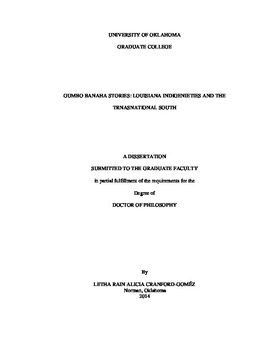| dc.description.abstract | Abstract
Post devastation of hurricanes Katrina and Rita, Louisiana has again become a popular exoticized presence in the American entertainment machine. As a result, scholarly studies have renewed interest in the historic ethnic diversity of Louisiana’s complex chronicles and the Southern gothic tropes associated with the state. However, few have sought to connect the Indigenous diasporas of Louisiana’s Native and Creole peoples with its textual productions, unveiling, or unsilencing our own narratives about ourselves as Indigenous peoples: Native, Creole, and/or Cajun. Partly in response to renewed sensationalism surrounding the Pelican State, yet mostly driven from Indigenous ties to land and preservation of culture in the face of continued erasure— this project focuses on issues of reinserting Louisiana Indigenous presence into texts of Southern literary expression in the modern era. In the broadest sense, it addresses issues of Indigenous (Choctaw/Caddo/ Houma/Chitimacha/Tunica-Biloxi) tribal peoples, within the Southern diaspora and their relationships with Louisiana Creole (primarily) and Cajun (secondarily) Indigeneity as manifested through textual representations. This research locates Louisiana Creoles as mestiza/os whose culture rises out of an Indigenous experience through a similar history of dominance as Mexican/Chicana/o culture, and other mestiza/o peoples of the Caribbean and Gulf of Mexico Latinidad through applying a lens of Indigenous cultural theory, regional studies, history, and critical mixed race studies. Starting with uncovering the emblematic problem of assumptive Indigenous absence in popular Southern fiction, highlighting Gone with the Wind as a seminal text which assumes Indigenous narratives of absence. In response to assumptions of absence I offer a counter narrative examining issues of survivance through physics definition of friction and theoretical applications of place-centered story, applying this analysis through self-reflexivity and highlighting established and emerging poets within Louisiana. The text continues to explore complexities of survivance and place-centered story in the face of Indigenous marginalization and federal erasure for Louisiana Indians in Geary Hobson’s The Last of the Ofos and within the material culture of baskets and beadwork within Louisiana landbase. Next, a historiography of Red/Black rhetorics offers an overview of key African American and Native American texts, Red/Black authors, and publications. This establishes the complex history of African/Native cooperation, contestation, and co-authorship needed when negotiating the history of Louisiana Creoles; people who are members of both the African and Native diaspora. Next, the text moves to modern literary and cultural Red/Black rhetorical repercussions of trauma, Choctawan landbase, and violence evidenced in LeAnne Howe’s Miko Kings and Jeremy Love’s Bayou. Lastly, tracing the ways in which tribe, nation, Peoplehood, race, and travel have impacted both land and literary migrations, the final section ends with contemporary transnational or trans-Peoplehood Indigenous intertextualities, dialoguing works by Carolyn Dunn, LeAnne Howe, Sybil Kein, MonaLisa Saloy, Coco Robicheaux, and Roger Stouff. This allows an overall examination of Indian identity in the face of racial law, tribal/federal recognition within the state of Louisiana, and the complex histories of mestizo/métis Indigenous descended communities in the state through racial segregation as resulting from Jim Crow, which is at odds with the history of Louisiana pre-statehood. These works illustrate the geographic space called Louisiana, as Gulf, Caribbean, Southern, Indigenous, Mexican, French, Spanish and American. In doing so, it highlights both the historic complexities of Louisiana’s Indigenous diaspora as well as the ways that Louisiana’s Indigenous literatures are transracial and transnational in their dialogues. Finally, I assert that by challenging notions of Indigenous absence and Indigeneity, addressing complex transnational and transracial Indigenous histories and land ties, and asserting more traditional ways of connectivity such as the Peoplehood matrix, allows for clearer possibilities of kin-ties and community negotiation between sovereign nations and Indigenous descended communities fostering (Native and Creole) voices in the Southern literary canon. In this way, the very present and real community voices of Indigenous, Indigenous-descended peoples, including Creoles, are unsilenced as viable voices and Indigenous/mestiz@ presences in the American South, vibrant alive, still struggling for recognition while continuing cultural continuity. | en_US |
